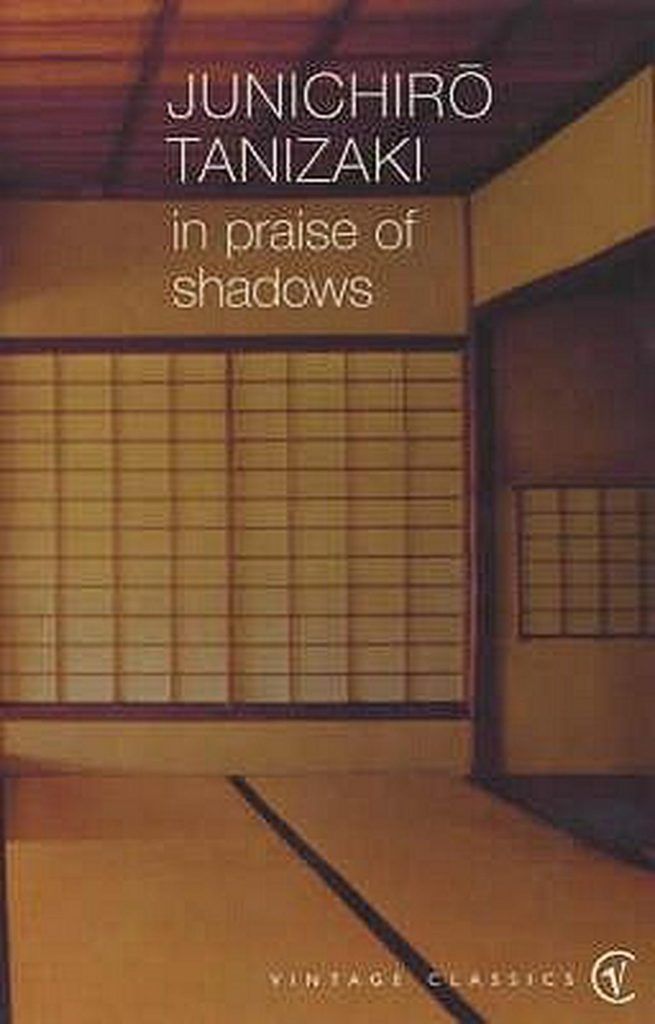In Praise of Shadows by Junichiro Tanizak
 In Prasie of Shadows by Junichiro Tanizak (translated by Thomas J. Harper and Edward G. Seidensticker)
In Prasie of Shadows by Junichiro Tanizak (translated by Thomas J. Harper and Edward G. Seidensticker)
Review
A beautiful book about Japanese aesthetics and the love of perception in the shadows at the edge of darkness.
This book is short and sweet and at well under eighty pages it flits between more weighty subjects of Shadows, Color and Architecture with seemingly more trivial ones, Japanese toilets, paper, wiring Japanese homes among the many.
Yet this extended essay gives a beautiful flavor of an original set of Japanese themes and their aesthetic value. It’s a bitter sweet book, the mourning of a Japan the author seems fully aware will pass with his generation. The beauty of the shadows hiding from the light of a candle in a traditional Japanese home has already given way in most towns and cities to the harsh electric lights of the west. The Author mourns their arrival while at the same time recognizing their inevitability.
Written in 1933 but only seemingly translated into English in the 1970’s it already portrays a world that has itself passed mostly into the shadows. But it serves as a beautiful fragment of the aesthetic whole of an ancient Japan just before its light fades.
Taniki sees Japan as a place of Shadows or the appreciation of them. The dim lighting or the world just between light and dark where colors themselves are different. The darkness and serenity of the traditional Japanese house. The lacquer of the pots and pans embodying the shadow light of these scenes. The grime of the dirt accumulated through use only adds to these qualities.
The writing style is fairly sparse which I really like, it gives the feeling of clarity and matches the argument of the book, I think that also it shows the work of a good translation in not loosing the feeling of the original, at least hopefully anyway.
Some sections though seem insular and broadly simplistic in extending reasoning for aesthetic differences, like skin colour or ideas of beauty in a woman, where cultural differences are only examples of an aesthetic divergence.
Criticism
Paul McInnes in Metropolis Japan reviews the book fairly negatively. His main complaint is similar to min and that it’s parochial;
It’s essentially an antiquated and parochial work which separates gender, race and continents without much thought or insight. Tanizaki’s voice, expertly interpreted by Starr, comes across as smug and self-absorbed and doesn’t particularly have any relevance to contemporary Japan, which bathes in light, wallows in plastic waste and systematically duplicates from other cultures in areas as varied as music and fashion to technology and language. Where are the shadows of Tanizaki’s age? Or was it an aging man’s wish-fulfillment to return to a glorious past which may or may not have existed?
Paul McInnes in Metropolis Japan
He also mentions an alternative theory, that it is at least mostly ironic bearing witness to the East-West discourse of the day. I actually agree with this criticism while I believe the writing about architecture and shadows to be beautiful the East-West sensibility seems to lack any self-awareness. It’s crass and strange to find in a book where the aesthetic insights can be profound.
So why is this book viewed as a classic and much recommended in the design community and definitely within Architecture schools? I think Charles Moore in his foreward best sums up the allure of the book when he says;
so it is when there comes to us the excitement of realizing that musicians everywhere make their sounds to capture silence or that architects develop complex shapes just to envelop empty space.
Charles Moore
This book speaks of the impression of something, the feeling it imparts and the chance of beauty to be found in the negative of something. It appeals not only as an alternative and very particular aesthetic sensibility that has passed but as a universal condition that just perhaps we can take a glimpse of.
It’s a great writers equivalent of a sketch, a flawed classic that every design student should read.
we find beauty not in the thing itself but in the patterns of shadows, the light and the darkness, that one thing against another creates.
Junichiro Tanizak
Section of the book
From the wikipedia article I have listed the sections of the book and added the introduction and appendix which frame the book nicely.
- Introduction by Charles Moore
- On construction
- The toilet aesthetic
- A different course
- A novelist’s daydreams
- On paper, tin and dirt
- Candlelight and lacquerware
- Bowls of broth
- The enigma of shadows
- An uncanny silence
- Reflections in darkness
- Shadows on the stage
- The woman of old
- Beauty in the dark
- A world of shadows
- A cool breeze in total darkness
- Final grumblings
- Afterward by Thomas J. Harper